From ACIG.org
Central, Eastern, & Southern Africa Database
African MiGs - Part 3
By Tom Cooper
Sep 2, 2003, 17:19
Little is known about MiGs in service with different African air forces. Except MiGs in Algeria, Egypt, or Libya (which are described in a separate gallery, to be found in the "North and Western Africa Data-base"), for example, standard reference publications mention only the numbers of MiGs operated by different African countries: pictures are either extremely rare, or not available.
The following series of artworks is based on what little evidence about MiG-17s and MiG-21s in service with different smaller African air forces since the 1960s is available, with emphasis on unusual camouflage patterns, national markings, serials, and special unit insignia. Part 3 covers the air forces of Mozambique, Nigeria, Somalia, and Sudan.
Note that this article formed the basis for the book "African MiGs", which is a delivering the full story of 18 Sub-Saharan air forces that flew or still fly MiGs, and specially detailing their combat operations. Details about "African MiGs" can be found HERE.
Any additional informations to this topic, including eventual corrections, would be most welcome.
Mozambique
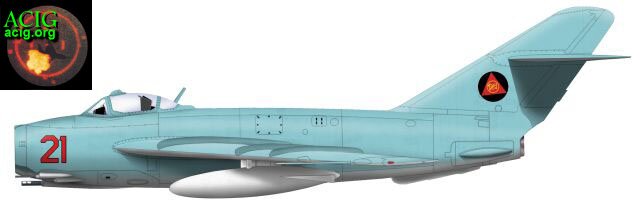 |
| Mozambique, spring 1981: Forca Aérea de Mocambique acquired 23 MiG-17s and two MiG-15UTIs from East Germany and the USSR in 1980 and 1981. The 12 East German MiG-17Fs and one MiG-15UTI were all former mounts from the Jagdbombergeschwader 31 (Fighter-Bomber Wing 31), incorporating Lim-5 modifications for MARS rockets): they were delivered to Beira in August 1981, after a complete refurbishment. A small number of East German pilots and technicians were also sent to Mozambique, in order to put the aircraft together, and test-fly them (the first plane was test-flown from Beira on 9 September 1981, by an East German pilot). The aircraft entered service already in October 1981. Reports about additional deliveries of two 12-plane batches in 1983 and 1984, each, were never confirmed. Already on 8 July 1981 Lt. Adriano Bomba defected with the MiG-17 "21", depicted here (c/n 5238) to South Africa: after some testing by the SAAF, the plane was returned to Mozambique. During the 1980s, MiG-17s were flown by two fighter-bomber squadrons stationed at Maputo AB: all were inoperational by the early 1990s. Other known serials are "22" (an example camouflaged dark earth/dark olive green over, light blue under), and MiG-15UTI, painted like the example above, and wearing the serial "20", as seen bellow. |
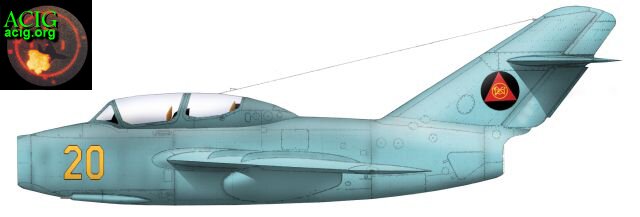 |
| Beira, August, 1981; this is one of two MiG-15UTIs supplied to Mozambique from East Germany. Note that the aircraft was actually seen carrying MiG-17-drop tanks. |
 |
| Beira, Mozambique, 1982; although the "Red 208" is claimed by some sources to have been a MiG-21MF, Mozambique is not known to have got any 21s of earlier versions. The FAM acquired a total of no less but 48 MiG-21bis from the USSR. By the early 1990s only 15 remained in service, even if the losses in the long and bloody war against the RENAMO guerillas were light. After the pull-out of Soviet and Cuban instructors in 1988/89, Mozambique lacked the capability of continuing to support its air force and the surviving examples were subsequently left to rust in hangars at Maputo and different other airfields. |
 |
| Mozambique, mid-1990s: "Red 241" has got its serial outlined in black, like several other Mozamiquan MiG-21bis, It was seen for the last time in decaying condition at the military side of the airfield in Maputo. Note the similarity of the camouflage pattern to that of the "Red 208" above: although Mozambiqan MFs were painted in at least three different camouflage patterns, this one was the most widespread, and was also applied on Congolese and the MiG-21s delivered to Burkina Faso, as well as - in a slightly different version - to Mali's MiG-21s. |
 |
| Escola da Aviacao, Beira, Mozambique, 1997; The fate of "Blue 247" was not much different than that of the other two Mozambiquan MiG-21bis shown above; the last time it was seen in front of the building of the local flying school, at Beira, in 1997. The aircraft obviously suffered damage during some kind of an accident connected with the collapse of the left main landing gear strut, as the lower intake lip and the left wing-tip were damaged. Other known serials of Mozambiquan MiG-21bis' are "Yellow 202" and "Red 240": almost all were applied in a slightly different style (fonds): some with, and others without the outline, possibly indicating their actual sources (East Germany, USSR etc.), |
Nigeria
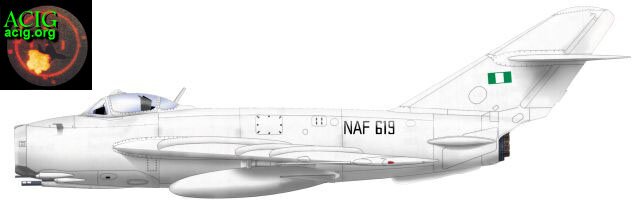 |
| Lagos (Nigeria), August 1967; "NAF619" should have been one of the MiG-17Fs supplied to Nigeria directly from the USSR. It is known to have been flown by one of the British mercenaries contracted for a pay of GBP 1.000 a month. The first six MiG-17Fs were supplied to Nigeria directly from the USSR, aboard Aeroflot An-12 transports. (All artworks by Tom Cooper; copyright 2003, all rights reserved) |
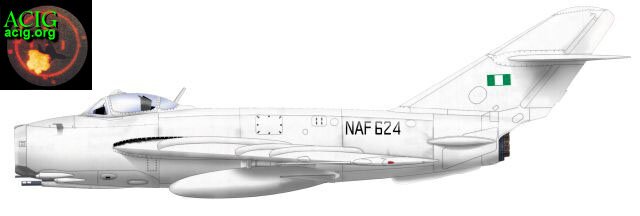 |
| Port Harcourt (Nigeria), 1969; "NAF624" could have been one of the MiG-17Fs supplied later during the Nigerian Civil war, either from Poland or from Egypt. |
 |
| Kano, Nigeria, sometimes in the 1970s; in 1975 the USSR delivered 25 MiG-21MFs and six MiG-21Us to Nigerian Air Force. These were in service with two squadrons at the same air base for most of the 1980s. By early 1990s economic problems have resulted in most of the MiGs being grounded: by the time only some 12 MiG-21s and five MiG-21Us remained intact, of which barely a handfull was operational, so that they were of little use when the NAF became involved in several local conflicts. |
Somalia
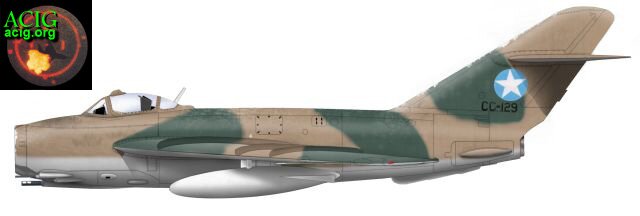 |
| Hargheisa, Somalia, 1977: Somalia acquired a total of 54 MiG-17s and MiG-17Fs in 1967 directly from the USSR. At least a squadron of SAC MiG-17s was based at Hargheisa, from where they also participated in the Ogaden War, against Ethiopia, in 1977 and 1978, when most were flown by Pakistani mercenaries, and at least one known to have been shot down by Israeli mercenaries flying F-5As for Ethiopian air force. This example, CC-129, survived the Ogaden War and later fighting against different oppositional groups inside Somalia, but was then disassembled at Mogadishu, and used as spares source. |
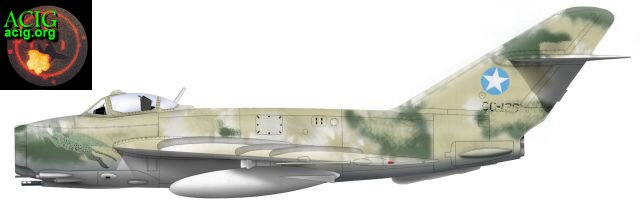 |
| Mogadischu, Somalia, 1992: by 1992 the Dayuuradaha Xoogga Dalka Somaliyeed (Somalian Aeronautical Corps) ceased to exist. The last nine MiG-17s - including the CC-136, which is also spotting a faded "Flying Cheetah" insignia on the nose (this insignia was carried also by several other SAC aircraft, including a MiG-15UTI and an An-26 transport) - and two MiG-15UTI were found in a relatively intact condition at the Kismayu AB, in northern Somalia, in 1992. Contrary to those airframes which were based at Mogadishu AB, these survived solely due to the fact that in the last days of his rule the former Somalian dictator Barre ordered the air force to deploy most of its available aircraft to the north of the country, where these were to fight local dissidents. |
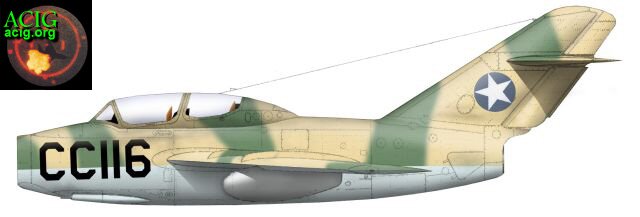 |
| Mogadischu, Somalia, 1992; on the "MiG Graveyard" consisting of former Somali Air Corps aircraft found in derlict condition at Mogadishu AB, by US troops, in 1992, also three MiG-15UTI or FT-2s were found, including the example CC116 depicted here. Nothing closer is known about this aircraft, except that it was in the best condition of all three - unless unceremonially removed by the buldozers of the Seabees. |
 |
| Mogadischu, Somalia, 1992; the SAC received a total of 24 J-6s and TF-6s from China in 1980, most of which were from production Batch 105, and some from the Batch 106, being produced alongside J-6s manufactured for Pakistan. For most of the early 1980s these aircraft were flown by Pakistani mercenaries, the first of which arrived in Somalia already during the Ogaden War, in 1977-1978. Due to the poor quality of work, as well as a chronical lack of spares, however, all were out of service within only few years. By 1992, when the US Marines arrived in Somalia, only five or six airframes were left intact, of which at least three were in derlict condition: 428 and 460, both found derlict at Mogadischu, together with an unknown example, and two others, found (almost completely washed out by the sun, sand, and rain) in Hargheisa. |
Sudan
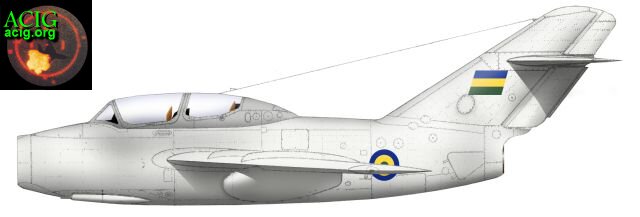 |
| Wadi Sayyidna, Sudan, late 1960s: in 1968 and 1969 Sudan acquired at least two FT-2s (Chinese copy of the MiG-15UTI), and at lesat one of these was seen still wearing the old Sudanese national markings, which were replaced with "pan-Arabic" markings in 1969. No details about serials are known. |
 |
| Wadi Seidma AB, Sudan, 1971: the Silakh al-Jawwiya as'Sudaniya (Sudanese Air Force, SuAF), acquired 16 MiG-21Ms and four MiG-21Us from the USSR in mid-1971; barely months later, most of the Soviet instructors were expelled out of Sudan because of their involvement in an attempted coup against the President Nimeiri. Thus, the availability rapidly sank, and for most of the 1970s the aircraft were maintained foremost with the help from Egypt. By 1979, 14 Ms and 3 Us were still intact, but only 50% serviceable. Due to permanent use of the SuAF aircraft in the frequent skirmishes with Ethiopia and Uganda, as well as the civil war against SPLA rebels in the south of the country, already two years later the number of available MiG-21M airframes fell to eleven, and by 1984 only nine remained. Despite some reports, no Sudanese MiG-21s were ever delivered to any other country, especially not to Iraq, in 1980 or 1981. From 1988 remaining eight Sudanese MiG-21s were gradually replaced: first by 12 MiG-23BNs from Libya, then - in 1992 - by ten MiG-23s from Iran, followed by 22 Shenyang J-7Ns, which arrived in 1995, from the last source. Iran also financed Sudanese purchase of 21 J-6s and two Y-8D transports from China, as well as four Mi-24s, from Kyrgizia, in 1994. Only half of these survived until today. |
 |
| Wadi Sayyidna AB, Sudan, 1981 or 1982: in the early 1980s, Sudan was given 12 J-6As from China. Except for the placement of their national markings, however, no details about their serials are known. |
 |
| Wadi Sayyidna AB, Sudan, late 1990s: since 1981 Sudan purchased a considerable number of F-7B, F-7M and F-7N fighters, partially directly from China, and in part from or via Iran. the first batch consisted of ten F-7Bs and two FT-7s, and was acquired in 1981. The second batch consisted of 22 F-7Ns, and was acquired in 1997 from Iran, and was followed by seven additional F-7Ms and one FT-7 acquired from China. The final batch of five F-7Ns was acquired in 1998. Originally, all were operated by No.2 Fighter-Intercept Squadron, but since the arrival of MiG-29 are flown by No. 2 Fighter-Attack Squadron. Some of 22 F-7Ns acquired from Iran in 1997 were painted in this interesting camouflage pattern, which closely resembles the one applied on Iranian and Saudi F-5Es. |
 |
| Luhovicbi AB, near Moscow, Russia, 2004: this is one out of a total of ten MiG-29SEhs and two MiG-29UBs Russia finally supplied to Sudan, in July 2004. Sadly, not all the details of the camouflage (especially in the fin area) and serials are known. |
Acknowledgments
As always, it is impossible to realize projects like this one without a team-work. Several persons were kind to share informations about "African MiGs" and thus instrumental for the final results; my special thanks go to Mr. Pit Weinert, Mr. Tom N., Mr. Jin Ho, Mr. Chris Thornburg, Mr. Alvaro Ponte, and Mr. Steve Touchdown.
© Copyright 2002-3 by ACIG.org
|


















